This authentic pasta al pesto recipe is bursting with flavor! Using simple ingredients and a homemade pesto, it's the ultimate comfort food. It's easy to make and takes less than 30 minutes!
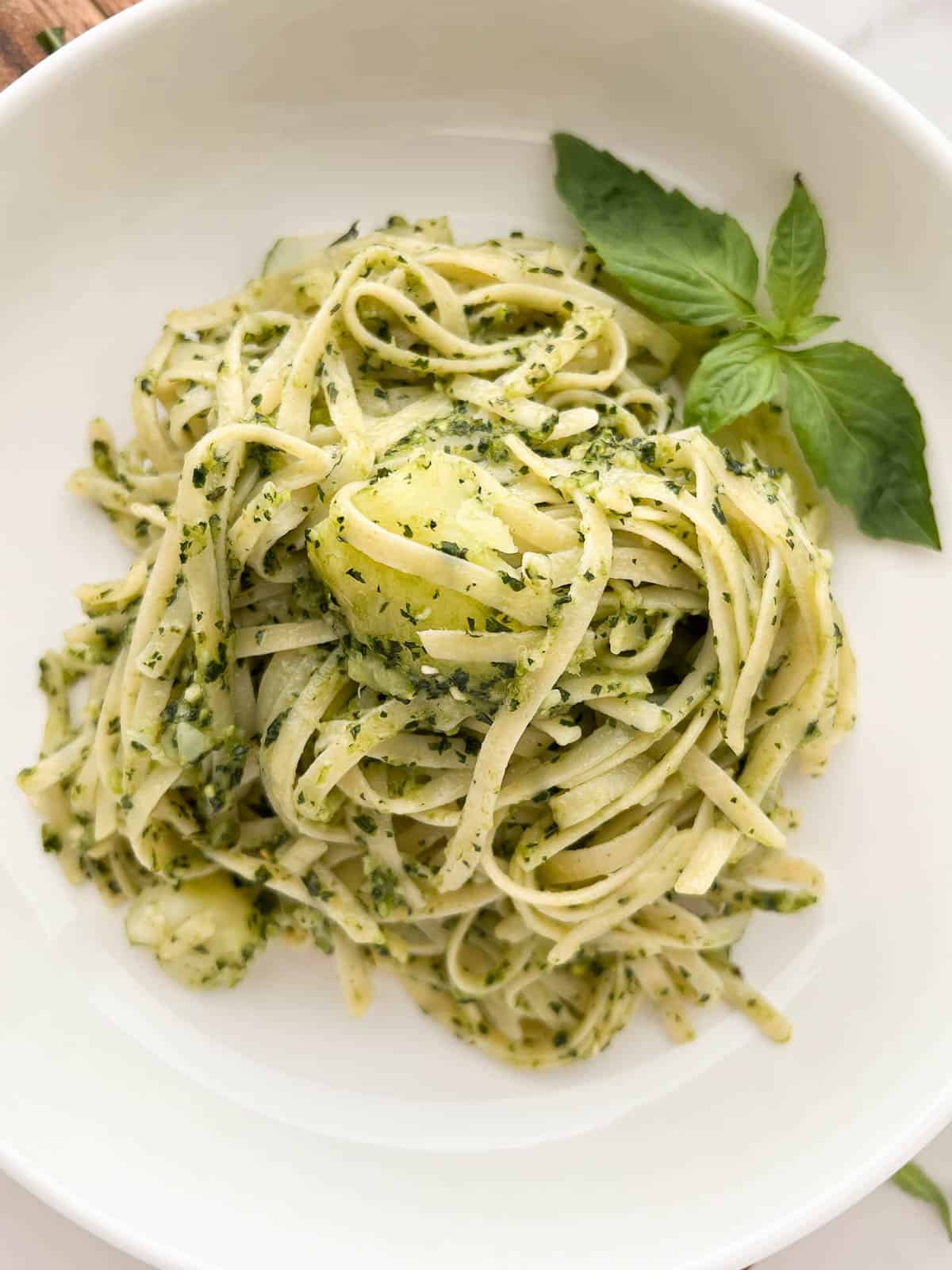
Save This Recipe! 💌
My family is from Genoa, Italy, the birthplace of incredible pesto. It's no surprise that pesto is very important to my family, being a dinner staple that I've enjoyed my whole life. My favorite food of all time is this pasta with pesto recipe, served Genovese style with potatoes. It's inspired by the pesto recipe that has been in my Italian family for generations! The light, bright pesto paired with the pasta and potatoes is comfort food at it's best.
There is nothing that compares to homemade pesto. It's a great example of how simple ingredients can make the most flavorful sauce. The secret to the best pesto is using quality ingredients with extra virgin olive oil. It's incredibly easy, comes together in minutes, and is more flavorful than packaged versions.
If you love pesto, you're in the right place! You'll want to try this ricotta pesto pasta, a creamy, satisfying dish made with the pesto in this recipe. Check out my Ligurian focaccia, a recipe that originates from the same region of Italy as this pesto recipe. The tomatoes in the focaccia are the perfect complement to the fresh, bright pesto. This burrata caprese salad is another great option that brings out the basil flavors in the pasta. For a delicious Italian dessert, check out my Italian almond cake, espresso ice cream, and walnut biscotti.
Jump to:
Ingredients
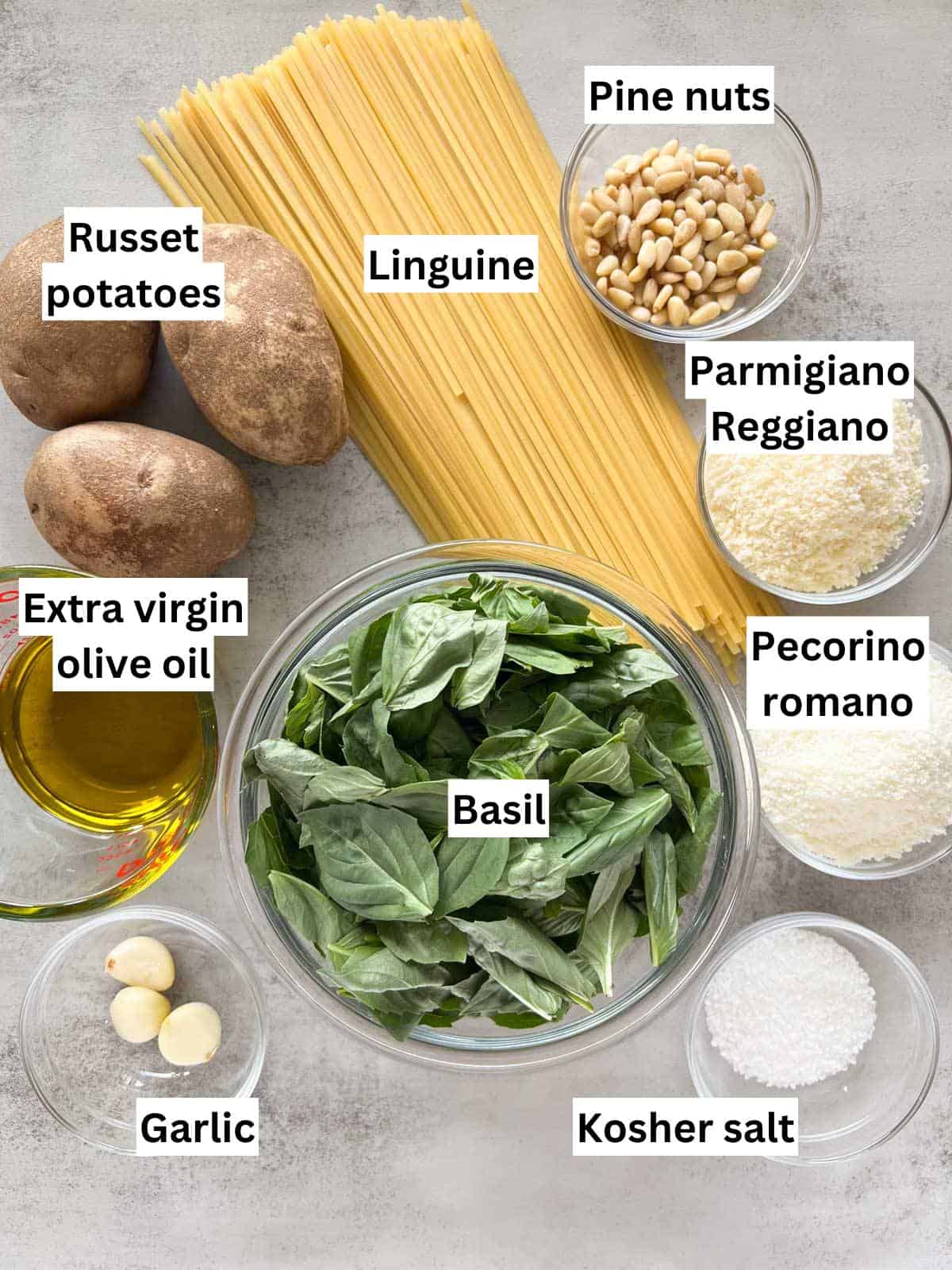
Ingredient Notes
- Basil: this recipe uses fresh, sweet basil leaves. The best kind for pesto is Genovese basil, a sweet basil variety with a vibrant flavor and slightly larger and darker green leaves. If this is unavailable, regular sweet basil works well! For the best flavor, the basil should be fresh and not wilted. If using store bought basil, purchase it right before you make the recipe so it will be fresh. If you have any leftover, I recommend making this delicious basil balsamic vinaigrette. I never like to waste basil because it's delicious and full of antioxidants and vitamins!
- Extra virgin olive oil: this is the base of the pesto, making it ideal to use a high quality oil. Extra virgin olive oil provides the most authentic flavor. It's less processed than regular olive oil and an excellent source of heart healthy fats.
- Parmigiano Reggiano: I prefer to use DOP certified Parmigiano-Reggiano for it's incredible flavor and quality. It comes from designated regions of Italy and is aged at least one year, giving the cheese a nutty, complex taste. To verify DOP certification, look for the following: the words "Parmigiano Reggiano" in pin-dot lettering on the rind and a red and yellow DOP seal on the label. I buy it in a block and grate it myself for the best flavor. If Parmigiano Reggiano is unavailable, you can use regular parmesan cheese instead.
- Pecorino Romano: the addition of pecorino adds an amazing depth to the pesto. The salty, tanginess enhances the parmesan and basil flavors. Like with the Parmigiano Reggiano, I prefer DOP certified Pecorino Romano for it's quality and amazing flavor, grating it myself for freshness. If pecorino is unavailable, aged Asiago or Grana Padano cheese would be a great option.
- Linguine: I love to serve pesto with longer cuts of pasta. Linguine is ideal because of the long cut and wider width that holds onto the sauce. When choosing dried pasta, I prefer those with simple ingredients, often just durum wheat semolina.
- Russet potatoes: pasta and potatoes? Yes, you read that right! The traditional, Genovese version of pasta with pesto includes potatoes. It truly makes this dish the ultimate comfort food. I love using russet potatoes because they are light and fluffy, which perfectly complements the al dente pasta.
See recipe card for quantities.
Substitutions and Variations
- Use a different nut: you can substitute the pine nuts with another nut of your choice. Delicious options include walnuts or cashews.
- Dairy-free pesto: omit the cheeses for a dairy-free pesto. Some members of my family prefer this dairy-free version! It's even a hit for a cheese lover like myself. Omitting the cheeses reduces the salt and volume of the pesto. You may need to season with more salt and use less olive oil than the recipe calls for.
- Add green beans: it's common for Genovese pasta with pesto to include green beans. They add brightness and texture. It's a fun way to add a veggie and they can be boiled in the same pot as the potatoes and pasta.
- Switch up the pasta shape: you can substitute the linguine with other long cuts of pasta, including spaghetti or fettuccini. It also goes great with fusilli, as the corkscrew shape holds onto the pesto. Bonus points if you can find trenette or trofie, the traditional Ligurian pasta shapes that go well with pesto!
- Use a different potato or omit them: you can substitute the russets for a potato of your choice. New potatoes or Yukon golds are great options. You can also omit the potatoes if you prefer.
Instructions
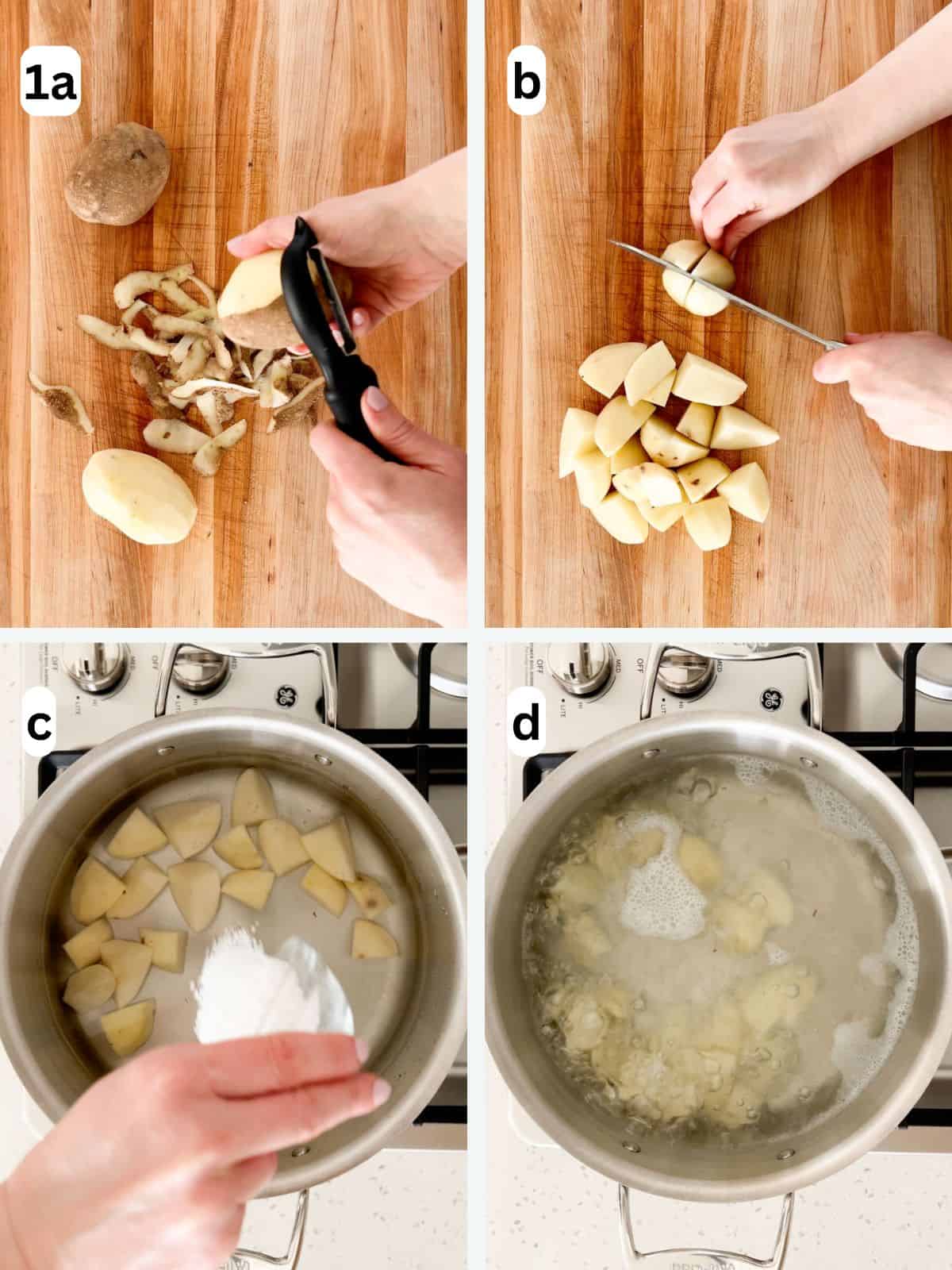
Step 1: Wash and peel the potatoes (image 1a). Cut them into even-sized pieces about 1 to 2 inches wide (image 1b). Then place the potatoes in a large pot with water. Add salt and stir (image 1c). Bring the water to a boil and boil the potatoes for 5 minutes (image 1d).
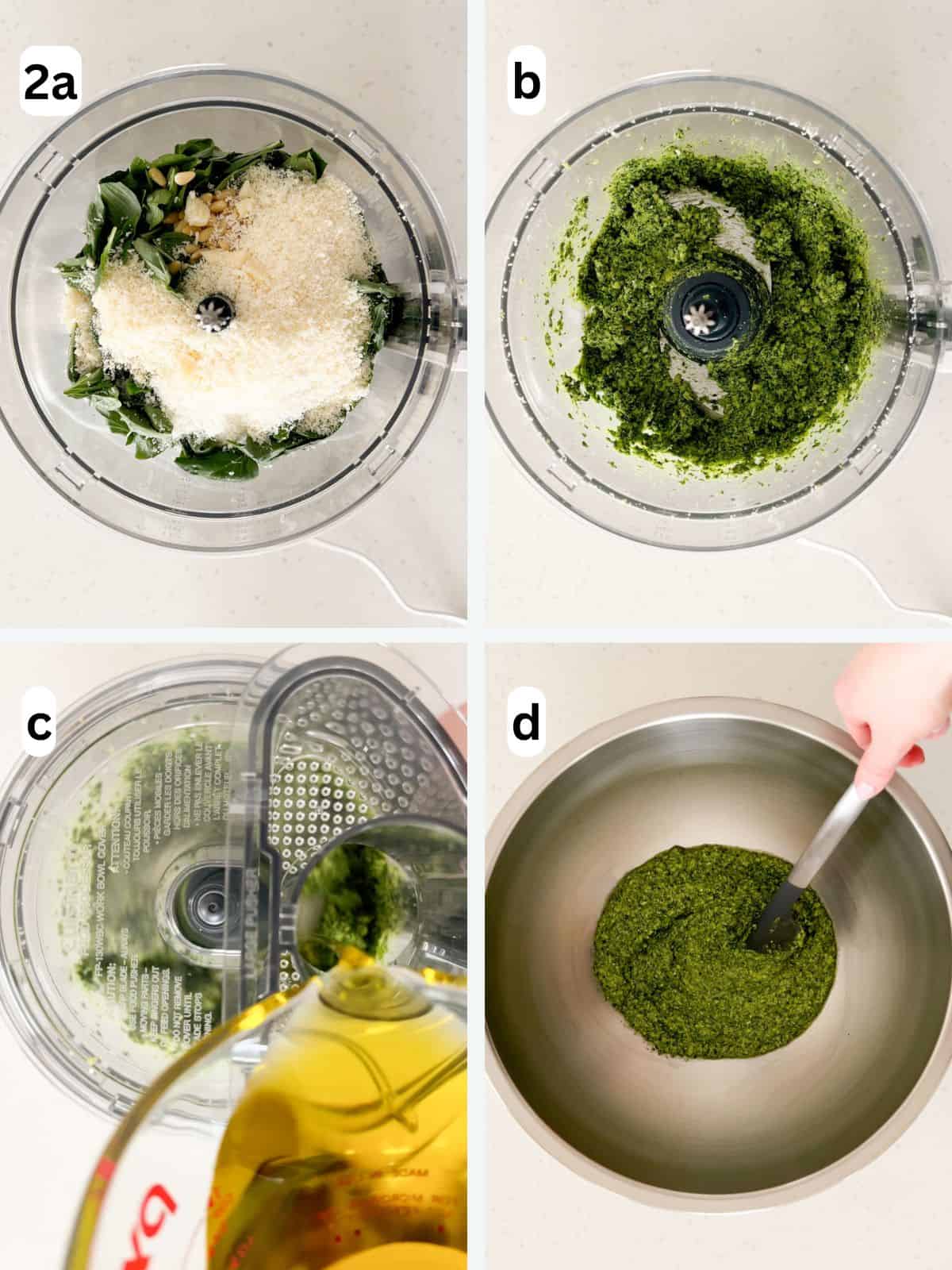
Step 2: While the potatoes are boiling, put the basil, pine nuts, garlic, Pecorino Romano, and Parmigiano Reggiano in a food processor or blender (image 2a). Pulse the ingredients until they are finely chopped (image 2b). While still pulsing, slowly pour in the olive oil (image 2c). Pulse until the pesto is combined but slightly chunky. Then transfer the pesto to a large bowl and season it with salt to taste (image 2d).
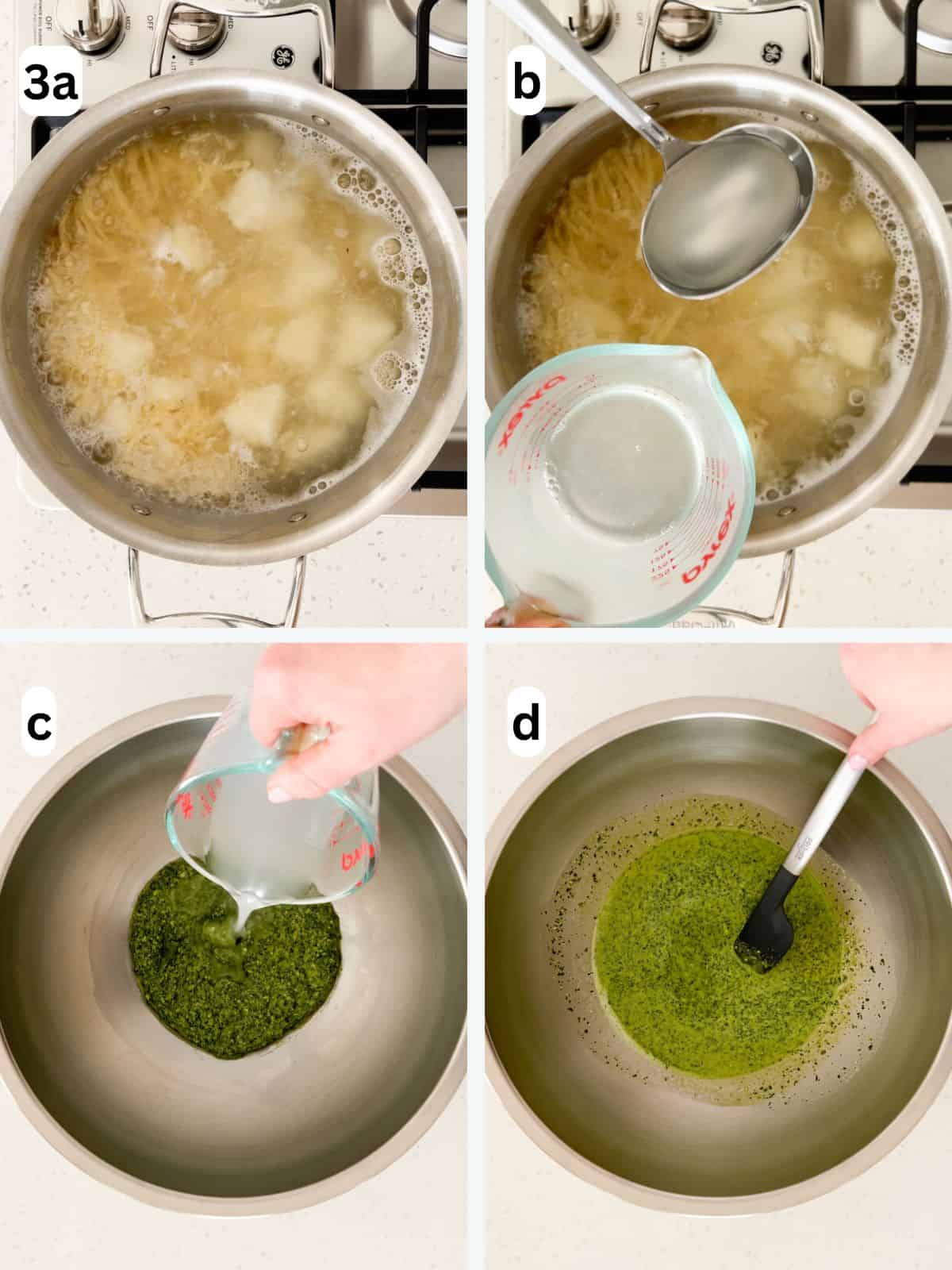
Step 3: After the potatoes have boiled for 5 minutes, add the pasta to the same pot (image 3a). Boil together until the pasta is al dente (about 8 to 10 minutes). Just before draining the pasta and potatoes, reserve 1 cup of pasta water (image 3b). Pour ½ cup of the pasta water into the bowl with the pesto (image 3c), mixing to combine (image 3d). Set aside the rest of the pasta water for later.
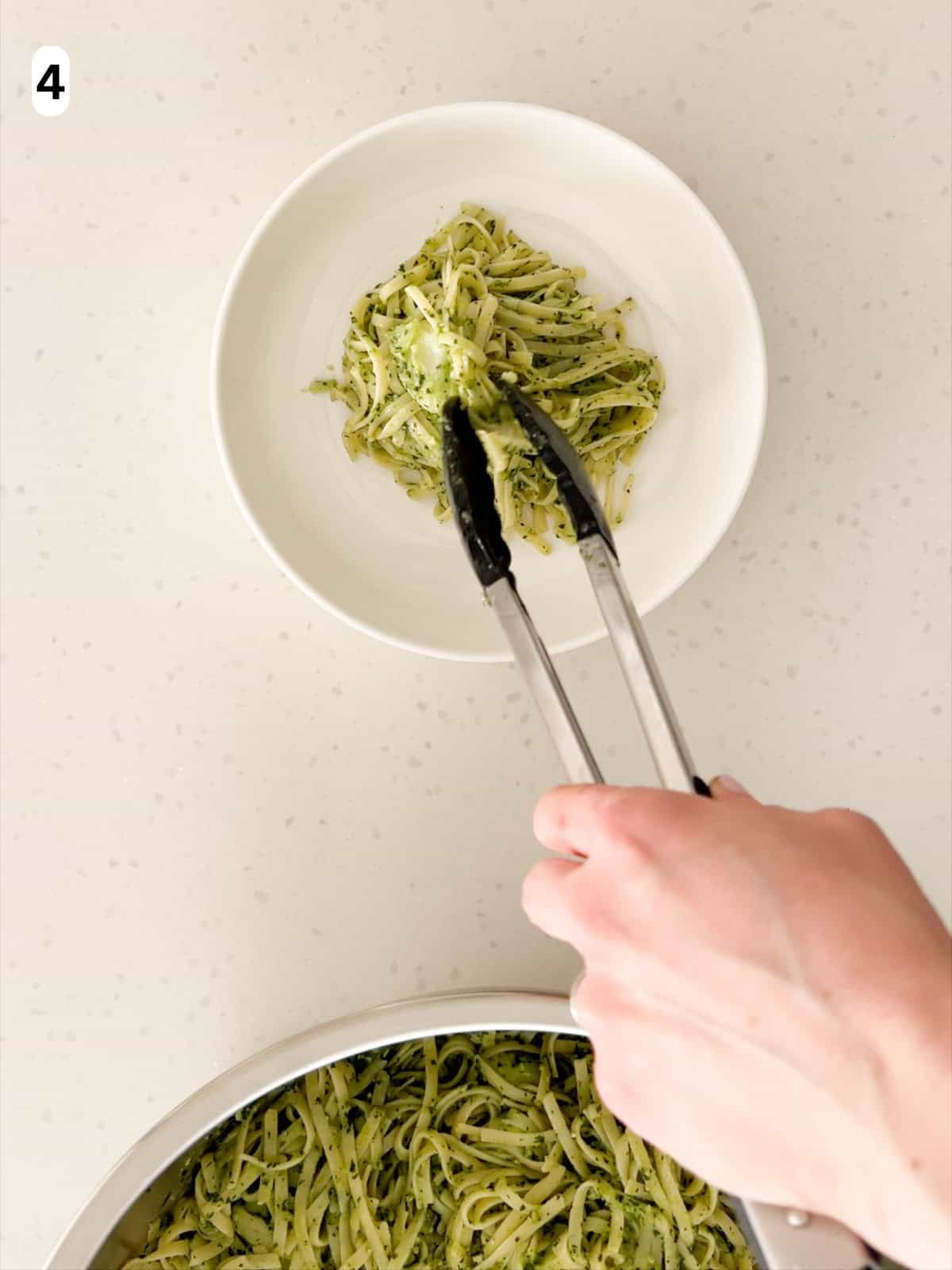
Step 4: Add the drained pasta and potatoes to a large bowl with the pesto. Toss together until evenly coated. Add more pasta water as needed for the desired consistency. Serve immediately while warm (image 4). Enjoy!
Equipment
- Food processor or blender: Although both will work, I prefer a food processor since you can pulse the ingredients and have better control over the pesto's texture.
Storage, Reheating, & Make Ahead
- Storage: you can store leftover pasta al pesto in an air tight container in the refrigerator for up to 3 days. I like to refrigerate a bit of pasta water as well, to freshen up the leftovers. I don't recommend freezing because the pasta can become mushy.
- Reheating: splash a bit of pasta water over the leftovers to freshen them up. Then reheat in a skillet over medium-low heat or in a microwave safe bowl, using 30-second increments in the microwave. All leftovers should be heated until they are 165°F (74°C) throughout.
- Make Ahead: you can make the pesto ahead of time, but do not cook the pasta. Store the pesto in an airtight container with a small layer of olive oil on top to preserve it's freshness and minimize browning. You can keep it in the refrigerator for up to 3 days or in the freezer for up to 3 months. Thaw overnight in the refrigerator before use. If freezing, I love to store the pesto in an ice cube tray with a lid. I learned this trick from my dad, it's convenient and allows you to thaw just what you need!
For more helpful information about storing leftovers safely, check out this USDA Leftovers and Food Safety guide.
Expert tips
- Grate your own cheese for the best flavor. This also helps to avoid unwanted additives and preservatives that may be found in packaged, pre-shredded cheeses.
- Just before draining the pasta and potatoes, reserve 1 cup of pasta water and add half of it to the pesto. The starches and salt in the pasta water add an amazing depth of flavor, while allowing the pesto to evenly sauce the pasta without clumping. You can save the remaining pasta water for later on, as a finishing touch.
- Pulse the pesto ingredients in the food processor instead of blending continuously. This gives you a better control over the texture and prevents over-processing the ingredients. This also prevents the ingredients from overheating, which could affect the color and flavor of the pesto.
FAQ
Pesto is traditionally eaten with pasta, ideally longer cuts like linguine, trenette, or trofie. Since pesto is an uncooked sauce, these longer cuts of pasta hold onto the pesto without overwhelming the flavor. In traditional Genovese versions, it is common for pasta with pesto dishes to also contain potatoes and green beans. Pasta al pesto is best served with fresh sides that complement the brightness of the pesto. It goes great with arugula and spinach salad, burrata caprese, and fresh salads with bright dressings like white balsamic vinaigrette or basil balsamic vinaigrette.
Pesto originated in Genoa, Italy, and is traditionally made from fresh basil, pine nuts, garlic, salt, and a hard cheese such as Parmigiano-Reggiano or Pecorino Romano.
Related
Looking for more delicious pasta recipes? Try these:
Pairing
These are my favorite dishes to serve with pasta al pesto:
Did you make this recipe? I'd love to hear about it! Leave a star rating and comment below. Subscribe to my newsletter for new Italian recipes straight to your inbox!
Recipe

Pasta al Pesto
Save This Recipe! 💌
Ingredients
- 1 pound russet potatoes (about 3 medium potatoes)*
- 2 tablespoons kosher salt (plus more to taste)
- 3 cups fresh basil leaves
- ¼ cup pine nuts *
- 3 cloves garlic
- ¾ cup Pecorino Romano (finely grated)*
- ¾ cup Parmigiano Reggiano (finely grated)*
- ½ cup extra virgin olive oil
- 1 pound linguine (dried)*
Instructions
- Prepare and boil the potatoes: Wash and peel the potatoes. Cut them into even-sized pieces about 1 to 2 inches wide. Then place the potatoes in a large pot with water. Add the 2 tablespoons of salt and stir. Bring the water to a boil and boil the potatoes for 5 minutes.
- Make the pesto: While the potatoes are boiling, put the basil, pine nuts, garlic, Pecorino Romano, and Parmigiano Reggiano in a food processor or blender. Pulse the ingredients until they are finely chopped. While still pulsing, slowly pour in the olive oil. Pulse until the pesto is combined but slightly chunky. Then transfer the pesto to a large bowl and season it with salt to taste. I add about ½ teaspoon of salt in this step. Keep in mind you will later add pasta water to the pesto, which will increase the saltiness.
- Boil the pasta with the potatoes: After the potatoes have boiled for 5 minutes, add the pasta to the same pot. Boil together until the pasta is al dente (about 8 to 10 minutes). Just before draining the pasta and potatoes, reserve 1 cup of pasta water. Pour ½ cup of the pasta water into the bowl with the pesto, mixing to combine. Set aside the rest of the pasta water for later.
- Toss the pasta and potatoes in the pesto: Add the drained pasta and potatoes to the large bowl with the pesto. Toss together with tongs until evenly coated. Add more pasta water as needed to reach your desired consistency. Serve immediately while warm. Enjoy!
Video
Notes
- Russet potatoes: you can substitute these with the same amount of another potato of your choice. New potatoes or Yukon golds are great options. You can also omit the potatoes altogether.
- Pine nuts: these can be substituted with the same amount of another nut. Walnuts or cashews are delicious options.
- Pecorino and Parmigiano Reggiano: for the best flavor, I recommend grating your own cheeses. If Pecorino Romano and/or Parmigiano Reggiano are unavailable, you can substitute with regular parmesan cheese, aged Asiago, or Grana Padano.
- Linguine: you can substitute this for a different pasta shape. Long pasta cuts like spaghetti, fettuccini, trenette, or trofie go great with pesto. Fusilli is a delicious option because the corkscrew shape holds onto the pesto.
- Fresh pasta conversion: substitute 1½ pounds of fresh pasta for each pound of dried. Adjust the cooking time accordingly, as the fresh pasta will need less time. Keep in mind that the potatoes need to boil about 10-15 minutes total, and should be done at the same time as the pasta.
- Dairy-free version: omit the cheese for a dairy-free pesto. When doing so, you may need to add more salt to taste. When making the pesto, reduce the amount of olive oil to ¼ cup, adding more if needed to reach your desired consistency.
- Add green beans: it's common for Genovese pasta with pesto to include green beans. It's a fun way to add veggies and texture into the dish. Cut ¼ pound (110 grams) of green beans into 1 inch pieces and boil them at the same time as you add the pasta.
- Equipment: food processor or blender. I prefer a food processor because you can pulse the pesto and have better control over the texture.
- Storage: leftovers can be stored in an airtight container in the refrigerator for up to 3 days. I like to refrigerate some pasta water to freshen up the leftovers. I don't recommend freezing because the pasta can become mushy.
- Reheating: drizzle a bit of pasta water over the leftovers. Reheat in a skillet over medium-low heat or in a microwave safe bowl, using 30-minute increments in the microwave. All leftovers should be reheated to 165°F (74°C) throughout.
- Make ahead: you can make the pesto ahead of time, but do not cook the pasta. Store the pesto in an airtight container with a small layer of olive oil on top to preserve its freshness. Keep in the refrigerator for up to 3 days or the freezer for up to 3 months. Thaw overnight in the refrigerator before use.
Nutrition
The provided nutrition and storage information is estimated. Accuracy is not guaranteed.
See our Disclaimer for more information.
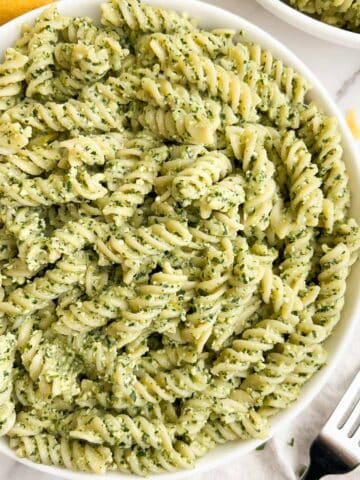
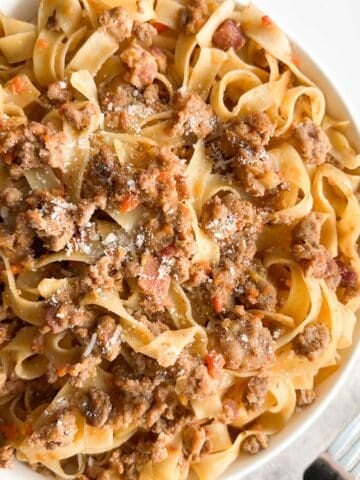
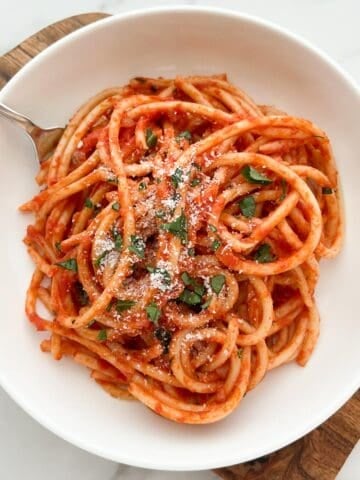
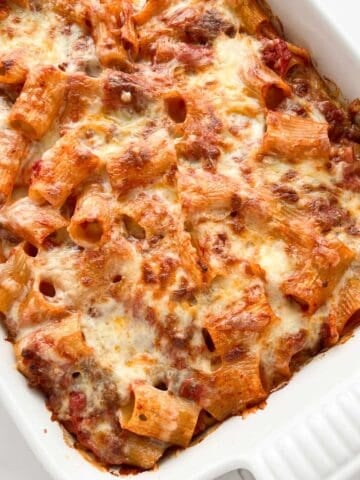

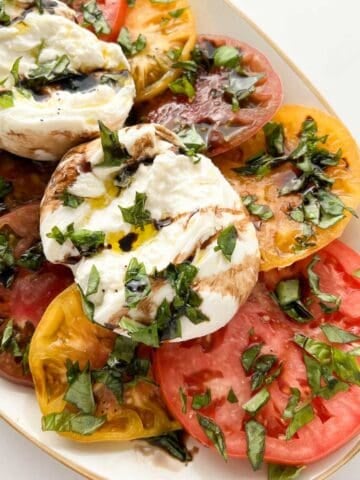

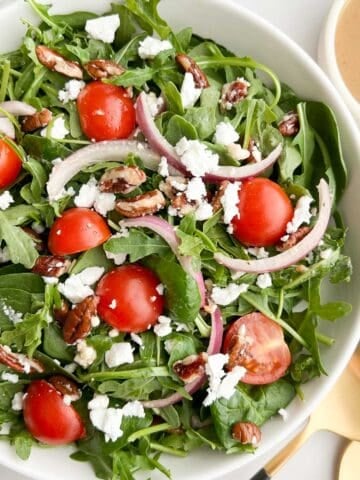
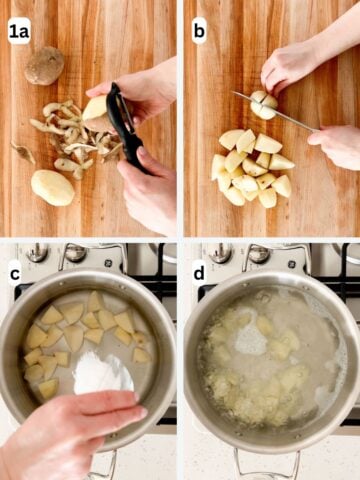
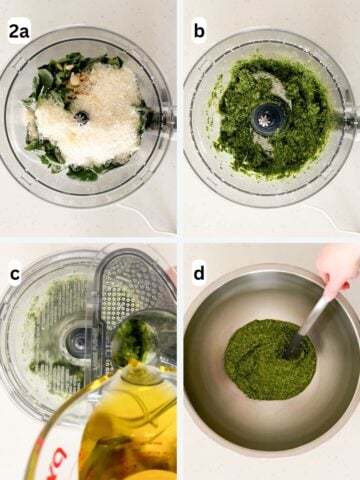
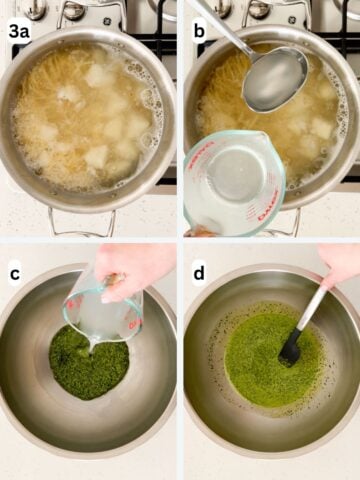
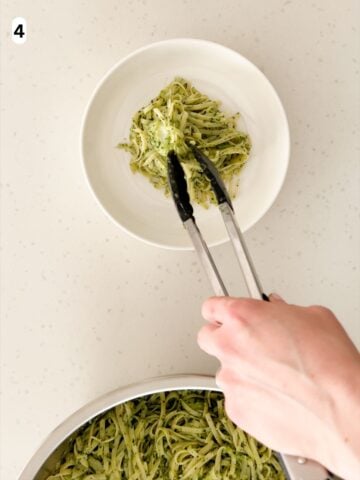
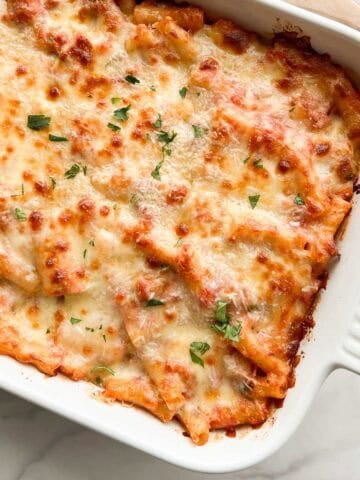
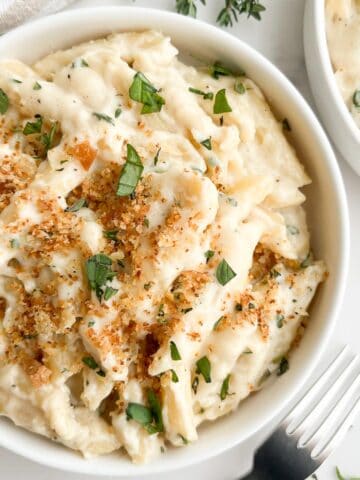
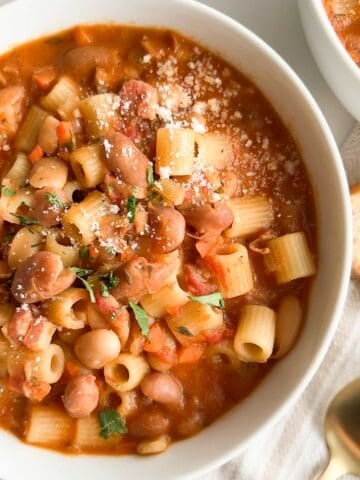
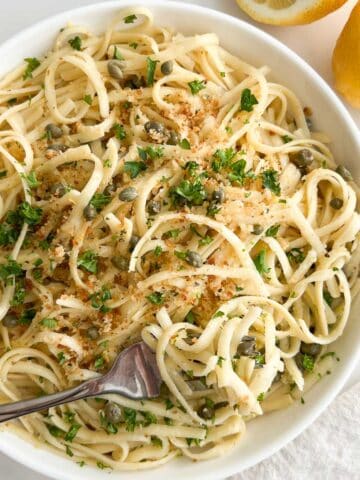
Anne says
Pasta with pesto is a favorite of mine. This recipe is easy to make and with the fresh basil is a true star. The potatoes mixed with the pasta make it extra special. I paired it with your homemade focaccia and my meal was complete.
Maria D'Errico says
Thank you, so happy you love the recipe. The fresh basil is a winner!
rd says
As a pasta lover, it takes something special to get me raving - and this pesto recipe is IT! I’ve eaten a LOT of pesto in my time, and this is my favorite recipe EVER. The flavor is rich and satisfying without any bitterness. The basil flavor comes through big time. The potatoes are the real secret star here, tender and delicious. If you want to impress with a gourmet pasta recipe, look no further!
Maria D'Errico says
So happy you love the recipe!